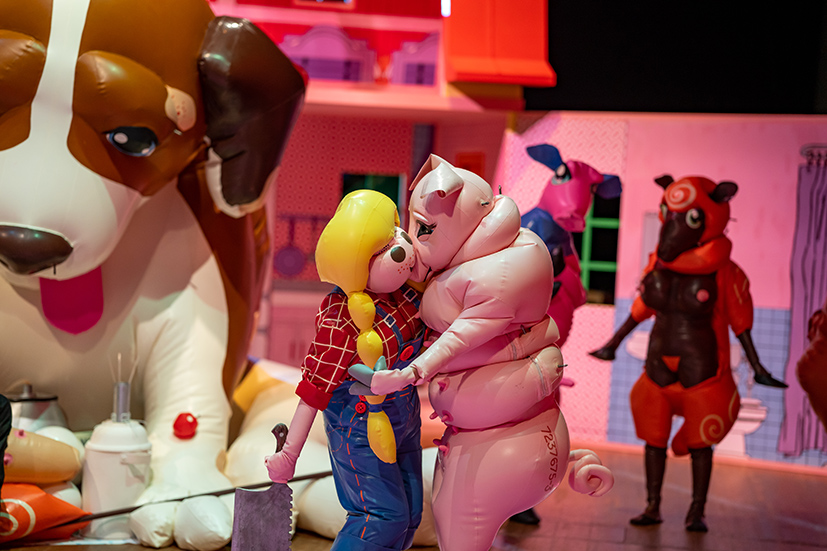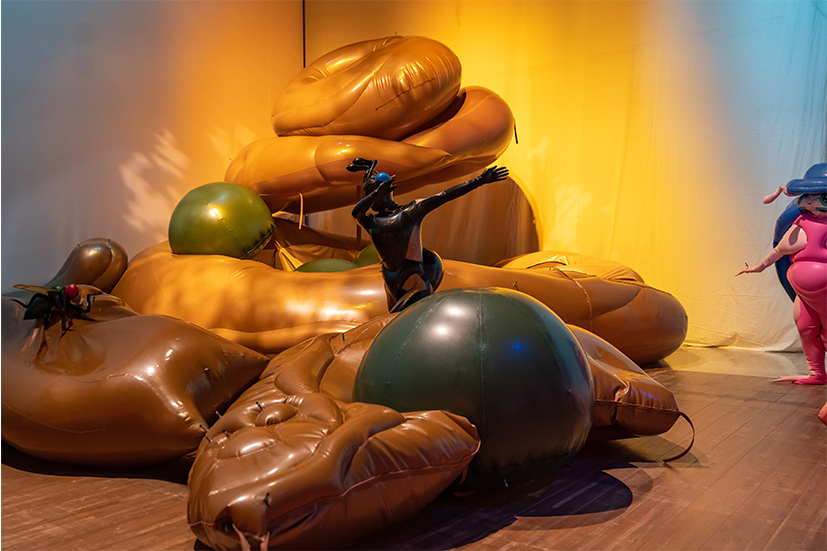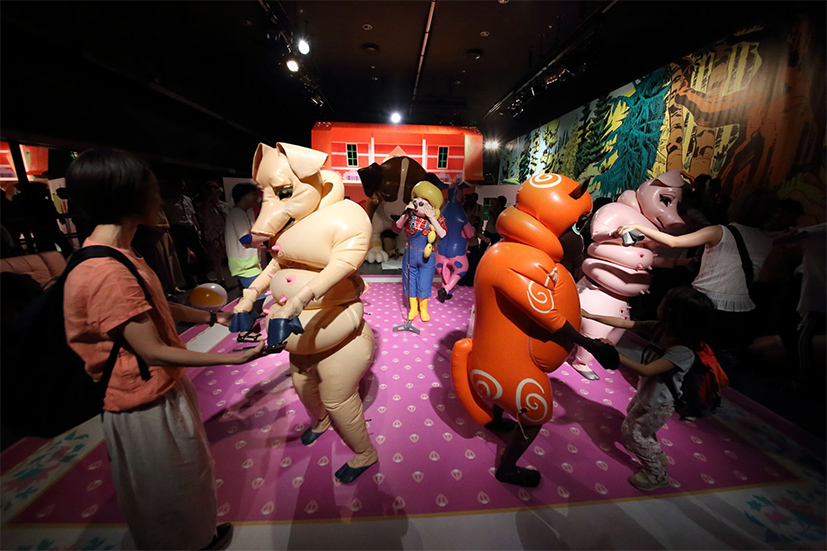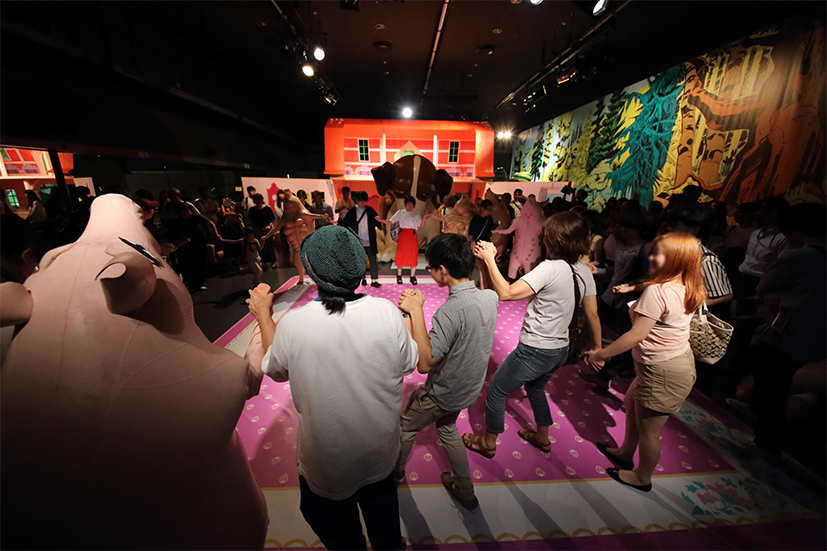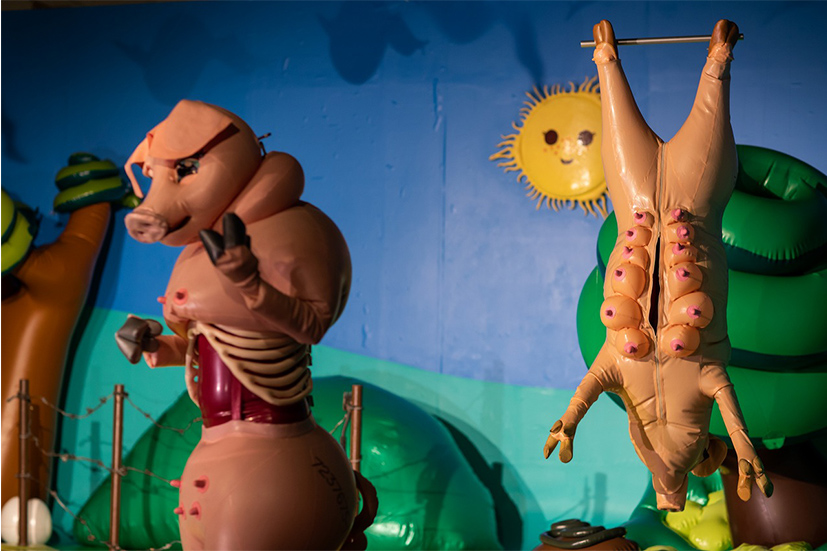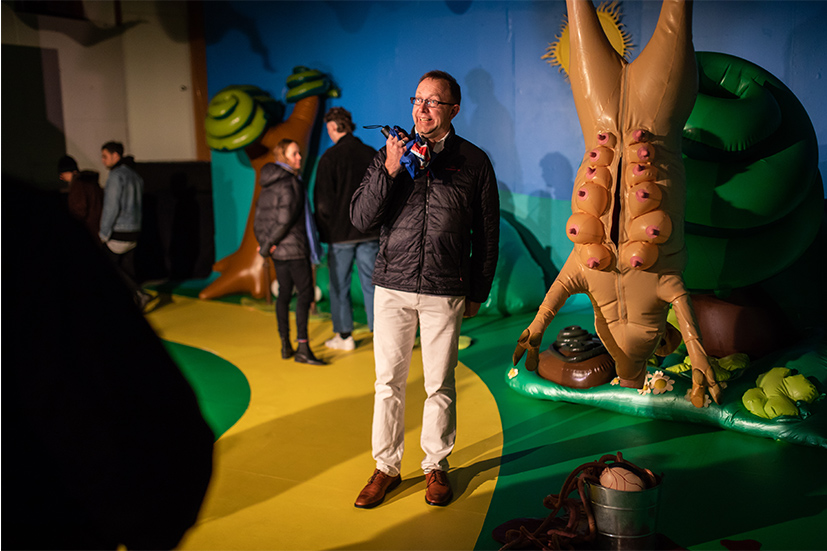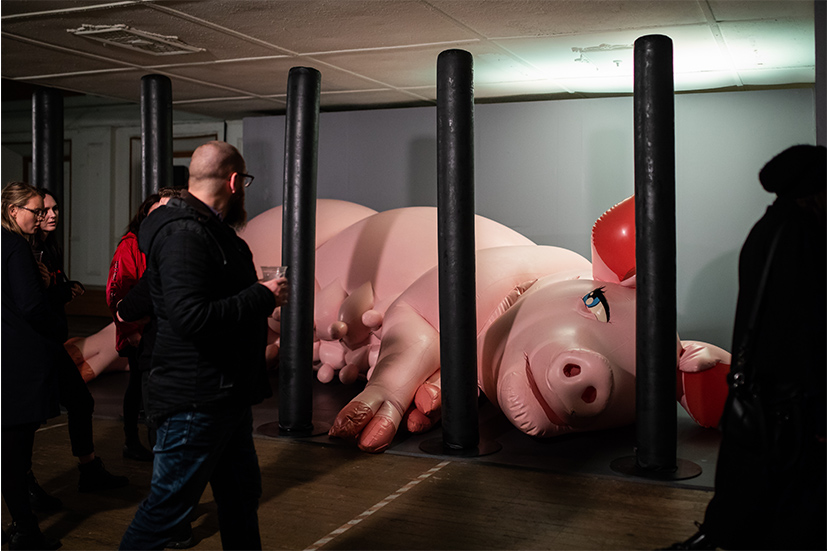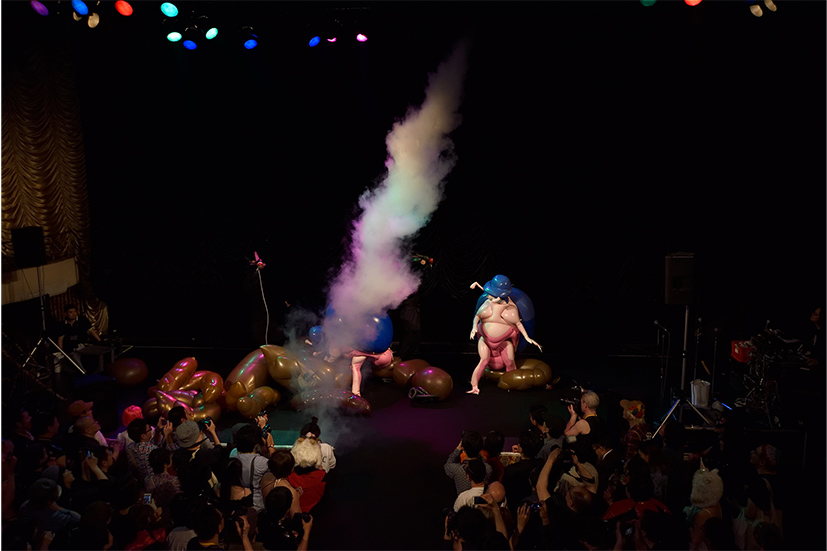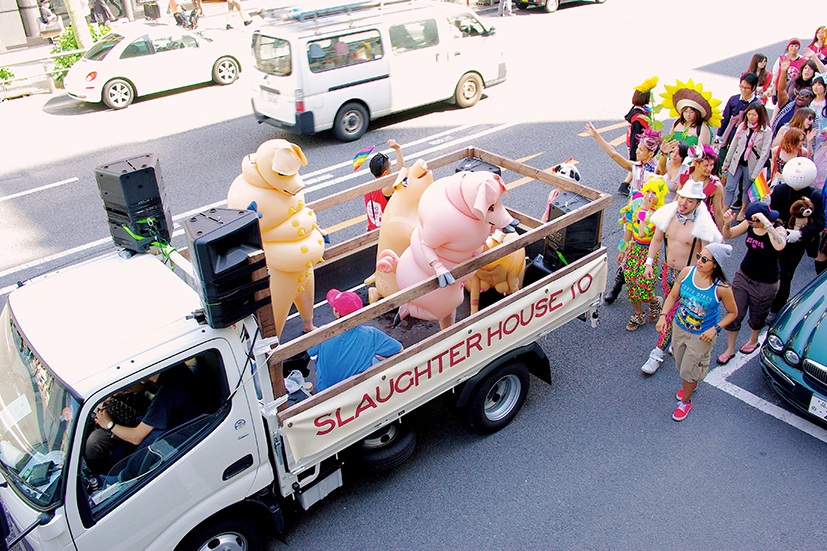Interview with an award winner
TCAA 2022-2024
Saeborg
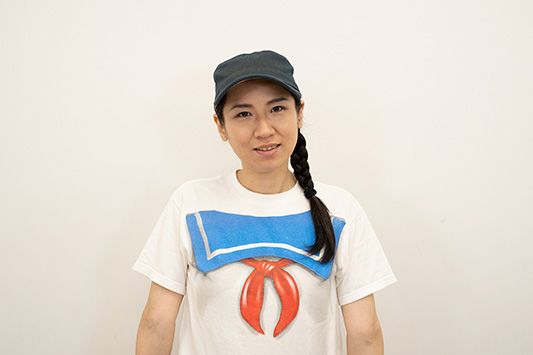
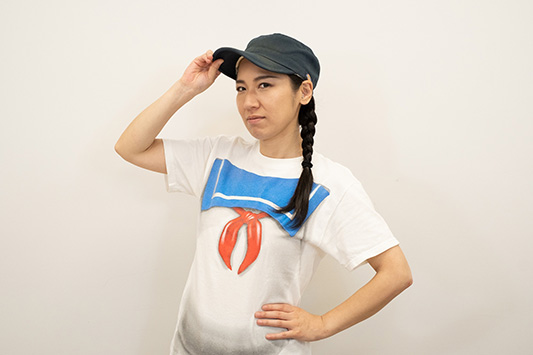
Saeborg is the name of the alter ego of the artist, who is an imperfect, half-human and half-toy cyborg, and performs wearing a self-made latex suit as an extension of her own skin. Saeborg has continued to present her manifestations at international exhibitions and art museums in Japan and overseas ever since her debut performance in 2010 at the Department-H (commonly known as “Depa-H”) fetish party, which has been held on Tokyo for over 25 years.
With stage decorations portraying a farm that looks like a massive dolls house, performers dressed in deformed costumes of sows and vermin perform “roles” such as giving birth, nursing, slaughtering, and stripping livestock. She shows the happily living world of animals that exists while their production is controlled like components at the depths of the homocentric food chain. The sight of the caricaturized long-running relationship between humans and livestock evokes not only the guileless cruelty and arrogance of mankind but also the exploitive structure rooted in “roles” and “attributions” in multiple layers of actual society, and is full of fierce challenges and criticism.
It appears that a lot of people from overseas, particularly those who haven’t actually seen the performances, make vivid responses over the internet. Performance videos that I posted on Instagram and Facebook some years ago still draw comments and are shared by foreigners I don’t know.
The videos that people who come to the performances and post on SNS have a really “live” feel as they were taken from an individual point of view, and that’s really interesting. Over 90% of the offers I get to perform overseas are made by curators who have seen posts that have been spread over SNS and researched on me.But in fact the performances that actually take place are around half-and-half the result of offers from people who have seen posts on SNS, and those who have actually come to see me perform.
When your work becomes diffused because of its visual impact do you think that the concepts and ideas in your work are transmitted as you intend? Among your works, what sort of reaction do you have about the ones using the motif of the farm and livestock now that we live in a day and age in which the ethical and environmental aspects of livestock and meat are being reconsidered?
When I started to perform in Japan many people interpreted my performances from a sub-culture or bad taste perspective. But the reaction overseas was completely opposite; many people overseas believed I was some sort of animal rights campaigner or a vegan. As I make costumes that look like toys, so it is frequently thought that I am opposed to animals being treated like toys. I’ve been told things like “Saeborg is voicing how precious the lives of animals are. And in a way that can be easily understood by children, too. Great!” I’m also asked “I suppose you are a vegan?” but it appears that the way that people in the West and the Japanese view animals is slightly different so I can’t make a response in the same verbal sense. There is also the matter of the history of classism, so I am unable to provide answers based on dualism. I didn’t even think about veganism when I started out creating my works, I just became interested in animal welfare in the course of producing them. A great deal of the feedback I get is off the mark, but I gain new perspectives from the way audiences interpret my work and I guess that this is not a bad thing in terms of expanding the possibilities of my works.
Wild animals live within the cycle of food chain of the natural world, but I think that the production and rearing system of livestock is something unique to human society. Could you explain about the background leading up to you gaining an awareness of the relationships between humans and animals, including animal welfare.
The concept of my work is to redesign myself by reassessing communication with livestock over the long history of mankind and livestock. I use the word “design” in its broadest sense that includes my own values and way of life, and rebuilding of my lifestyle. In 2019 I was invited to the Dark Mofo event that is held each year by the Museum of Old and New Art (MONA) in Tasmania, and the artist invited the previous year was Hermann Nitsch. I saw his performances on video but I didn’t find them to be in bad taste, I thought they were “festive” and I like them. However, the concept of animal protection in the Oceanian nations is really high, and his performances using pig blood caused a great stir. I suspected that I had been invited because the Museum wanted some sort of extreme show. My work was widely compared to Nitsch’s in local newspaper articles, some of which sarcastically described his show as impossibly boring. The tone was that in comparison “Saeborg’s work doesn’t use real animals so it’s OK!”
Perhaps the Tasmanian organizers were evaluating your stance and Nitsch’s, and making a critical comparison of your respective methodologies.
The Dark Mofo event appears to take as its theme the dark past of the island when the pioneers of Tasmania hunted down and massacred the Aboriginal Tasmanians. In order to reexamine the guilt they harbor at their origins they intentionally stage extreme and hardcore performances, and create a nighttime walking course that takes you along the paths used to hunt. They swear an oath that this land belongs to Aborigines, and I thought the strength of that awareness was wonderful.
You must have encountered concepts and ideas different to those in Japan, but what sort of creative awareness and motivation did you gain from these overseas experiences?
The place that I was recommended to visit during my stay in Tasmania was the Bonorong Wildlife Sanctuary. All along the roadside lie the corpses of kangaroos and wallabies that have been hit by vehicles. The animal protection centers rescue animals that have been hit by cars, and raise them while tending their injuries. The animals that have recovered sufficiently to be returned to the forests and mountains are released, and the disabled animals are kept alive there. The animals who you may think would hate humans after going through such terrible experiences actually interact with people. I thought that the workload at the center was very heavy compared to the inexpensiveness of the entry fee so I bought stacks of T-shirts and charity goods. There is a tremendous potential in the power to encourage people’s sympathy, to make them feel they have to help the animals. Though I went with the intentions of caring for the disabled animals, in fact I gained a sense of realization through the experience of feeling that it was I who was being cared for. That’s why during the “Aichi Triennale 2019: Taming Y/Our Passion” held the same year, in the work I performed called “House of L,” though the setting is that the audience look after the livestock, the livestock actually behave like companion animals looking after the audience.
It’s a work that make one think about the difference between wild animals and livestock, and moreover the differences between livestock and pets.
I’ve inspected a slaughterhouse as part of my fieldwork, but the time spent together with the animals before they are actually slaughtered is very long. You can’t go on holiday while you are rearing pigs and while it looks as though they are being tamed in fact they are being kept. I heard at a special exhibition event held at The University Museum, The University of Tokyo called “Love, Rear and Slaughter Livestock” that it is common when mentioning livestock to attach them to the problem of rationality in the capitalist system. However, having visited farms across the world it is not rationality (money) but there is so much livestock living that is being incomprehensibly kept. If the definition of livestock is that their breeding is being controlled, then pets must be counted as “livestock.” Animals such as so-called “companions animals” are performing a kind of “emotion-based labor.” In the sense that they perform care labor they are in fact doing the same things as humans. Pets are doing a job just by “being cute.” I mean, all they have to do is be there, isn’t it? Just by licking their owner’s hand they provide a sort of motivation to work hard for that pet’s sake. For example, it’s said that a housewife’s housework is a form of labor. Housework is an easily understood for of labor, but I think that it includes the subtle aspect of caring for the family I order to foster their vitality for the next day. In this sense everyone and everything is working.
Your performances start from the context of body reconstruction which is at the axis of the Department-H fetish party. Why are your costumes made of latex despite all the other materials available?
I’m attracted to being able to change my body with an artificial, plastic material. I can change back to my original state just by taking off my latex body suits, so the possibilities for changing my appearance are endless. The good point about latex is that it exerts pressure. It closes in tightly on my body and makes me sweat profusely; I don’t get a sense of wearing something unless I can feel that direct pressure is being exerted on my body. I wear latex suits with the wish of tinkering with my body and wanting to become free; as a result of releasing my mind, my body becomes less and less free. The suits can’t be put on all by yourself you always need somebody’s help. Once the costume is on, you need care from others since you will have difficulty moving around and bumping into all sorts of things.
The fact that the material itself of directly connected to the concept is unique. Among all the artists who have taken the contemporary arts stage while playing in the world of fetishism, there is a sharp irony in the way that your and Miyakawa Hikaru’s world of works have captured the hearts of people not interested in fetishism.
The desire to expand the body is something common through contemporary art, and there are amazing artists like Stelarc. Among the audiences who come to enjoy the Department-H event there are many who look as though they could be evaluated in terms of art, but it seems that many of them do not want what they are doing for their own pleasure to be criticized or have this and that said to them by other people. I think that’s the difference. In contrast I’ve never felt bad about any criticism, rather, I think that I am often being provided with new insights.
I’d like to ask about the recent selection process. Apparently, during a period when COVID-19 has subsided a little, the Selection Committee members in Japan visited your studio, and the members living overseas made online visits.
In the first-half 30-minute presentation I gave a passionate speech. I thought I would try my best in English and prepared a script that I practiced online with a friend. The second-half question and answer required spontaneous answers so I used an interpreter. I thought it was very important that although I could not respond to certain questions on the spot, those questions afforded me an opportunity to think about them. The word “award” tends to have connotations of people in positions of high standing making one-sided judgement, but the TCAA has a spirits of collaborative creation. My mentor from my university days was really pleased about my winning of the award and said “the judges who elected you are great! Make no mistake, the judges are constantly under scrutiny regarding their astuteness and from what perspective they may their selections; it’s the judging side that’s being tested!”
It’s not just that these people’s opinions and perspectives are being laid bare, they also have the responsibility of keeping pace with the subsequent activities of the recipient.
The mentor is a seminar teacher who really helped me a lot when I was attending an oil painting course at university, but also said ruthlessly sarcastic things to me. At university I was working on paintings seriously by day, and in the evening indulging in my real interest of going to have fun at Depa-H wearing the latex I love. I divided my own fetish and what I was doing in the world of art. My mentor really hit home saying “You go to Department-H wearing latex suits without batting an eyelid, but you can’t hold a private exhibition and so on with that same attitude. That means you’re ridiculing Department-H.” “Damn you, how annoying!” I thought; I had been seen through – the fact that inside me art was special and something that I thought I had to go about properly. That was the spur that made me decide to abandon separating art and fetishism, and take Depa-H seriously. While doing a part-time job I mulled over my plan and then gave a presentation to the organizer of Depa-H. I secured a place to express things I wanted to and decided to unveil a new work planned by myself every year. Even so, when I went back to my home in the countryside I couldn’t get my family to approve of my activities and felt hemmed in. When I spoke disconsolately the organizer of Depa-H laughed at me, saying things like “If you get so spineless about such things perhaps it means you’re not taking any pride in what you’re doing.”
Finally, perhaps you could tell us about your overseas research and creative activities after receiving the award.
I already had an appearance planned “Submerge Festival 2022” at Manchester in March, so I went there. It was the first time I had been overseas since the COVID-19 pandemic broke out. I had an offer from somebody who had seen a video of a performance I did previously at a fetish event in Melbourne. This was also a queer art-oriented performance event, and the participants were all really upbeat. On July 10 I will go to Sydney. I’m really happy that the exhibition at the Museum of Contemporary Art Australia that was postponed is now finally going ahead. The initial work will consist of installations, performance and the maintenance of the exhibition, and I will devote the rest of the time to research with the assistance of the TCAA. I have asked for some inspections of Australian animal welfare facilities to be arranged, so I’m looking forward to them. Then in October I will return to the UK and have one more performance in Birmingham. After that I’ thinking of crossing Europe and looking at various international art exhibitions like “La Biennale di Venezia.”
The driving force behind Saeborg’s works is a strong wish to overcome gender, the body and even humanity, stemming from her uneasiness about stereotyped female images, fixed identities and her own body. The way that she has developed her activities without turning her gaze from the “extension of the body” and “fetishism” that were vital factors in the subculture of the 1990s and 2000s, as well as the Tokyo underworld scene, provides a searing commentary on the burning issues of biodiversity, symbiosis, gender and care.
In an era in which we face life-threatening crises such as pandemics, war and global warming, Saeborg’s farm performances sometimes provide a hint from a socio-experimental perspective of how we humans should now behave in the course of our relationship with all our compatriots in the world of nature. And this can also be applied to the dynamics of our interpersonal relationships, which are becoming increasingly fractured and disparate.
interview, text: SUMIYOSHI Chie
